Olympus 9mm f/8 Fisheye Body Cap Review

Introduction
The Olympus 9mm 1:8 Fisheye is a very unusual Micro Four Thirds lens. Basically, it is a body cap with a tiny, fixed-aperture fisheye lens built in. The optical formula comprises 5 elements in 4 groups, including 2 aspherical lens elements. The Olympus 9mm f8 Fisheye Body Cap Lens has no electrical contacts and makes do without an iris diaphragm. It also lacks an AF mechanism but can be manually focused using a small plastic lever. For the above reasons the Olympus 9mm f8 Fisheye Body Cap is actually listed among “PEN and OM-D Accessories” – rather than lenses – on the Olympus website. Nevertheless, this is a lens that can be used to take pictures when mounted to a Micro Four Thirds camera, and we were eager to find out if its quality was good enough to justify the – admittedly not too high – price of £89 / $99 Olympus is charging for it.
Ease of Use
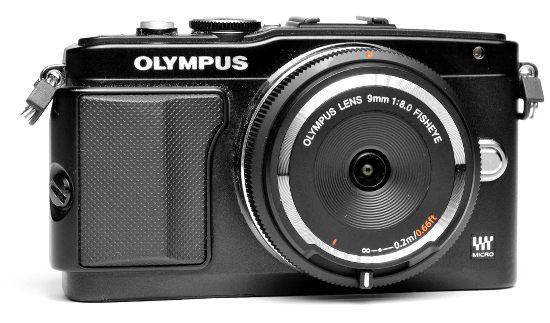 The Olympus 9mm f8 Fisheye Body Cap Lens mounted to an Olympus E-PL5 camera
The Olympus 9mm f8 Fisheye Body Cap Lens mounted to an Olympus E-PL5 camera
As seen in the photo above, the Olympus 9mm f8 Fisheye Body Cap Lens is really tiny – it's easily smaller than most pancake lenses, and not much thicker than a regular Micro Four Thirds body cap.
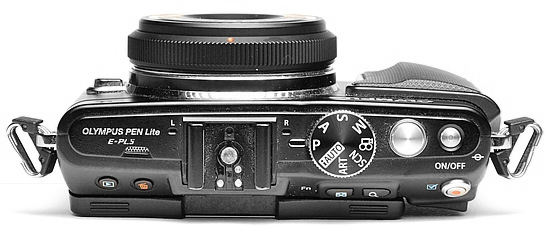 The 9mm body cap lens is really thin
The 9mm body cap lens is really thin
The ultra-thin lens is only 12.8mm “thick,” and weighs in at a mere 30 grams.
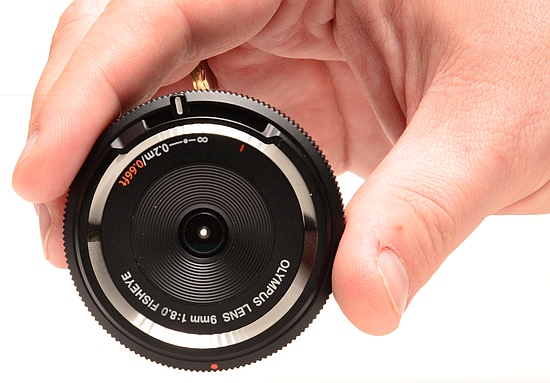
In terms of features, the lens has little to offer except for its super-wide angle of view and distinctive distortion characteristics. It even lacks an iris diaphragm, meaning its aperture is fixed at f/8. There's no AF motor, either, but you can focus the lens manually using a small plastic lever, which has click-stops at the closest focus distance of 0.2m, the hyperfocal distance and infinity. By sliding it all the way past the infinity setting, you can engage the built-in lens cover that protects the front element against abrasions, bumps and dust.
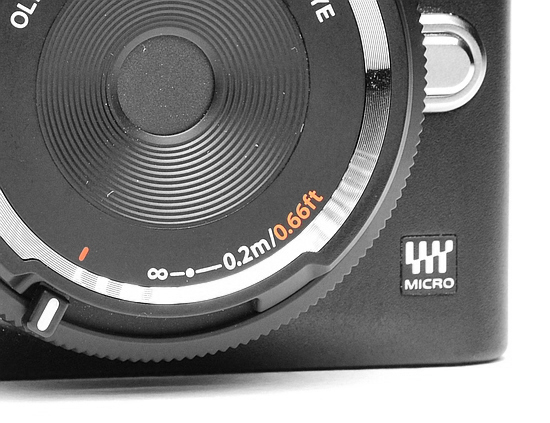 The body cap lens has a built-in lens protector
The body cap lens has a built-in lens protector
 The focusing lever set to infinity
The focusing lever set to infinity
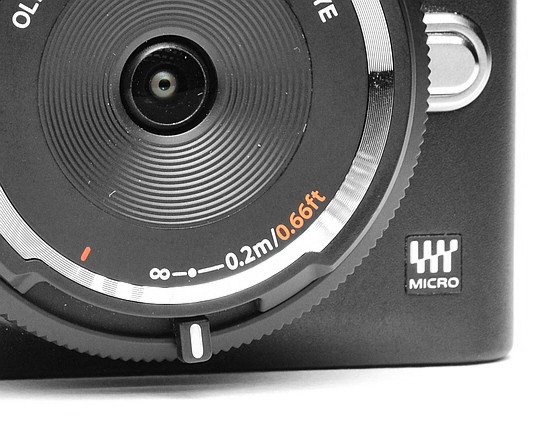 The focusing lever set to the hyperfocal distance
The focusing lever set to the hyperfocal distance
Given the vast depth of field that comes with a 9mm fisheye lens, you will probably want to leave the focusing lever set to the hyperfocal distance most of the time.
 The focusing lever set to the closest focus distance
The focusing lever set to the closest focus distance
However, if you would like to focus on a subject that's really close to the camera, you can slide the focus lever toward the 0.2m setting.
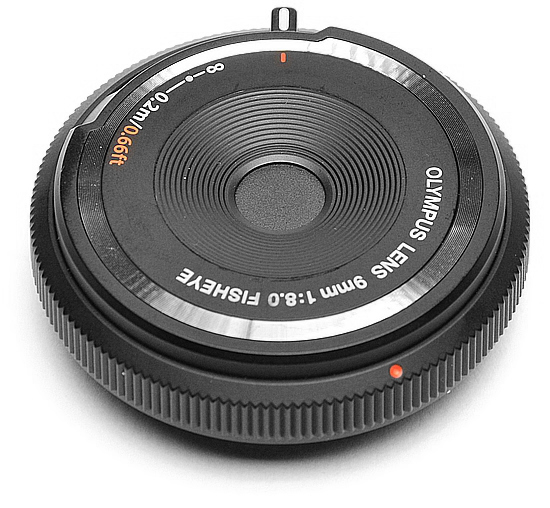 Front of the lens
Front of the lens
The Olympus 9mm f8 Fisheye Body Cap Lens does not take filters (neither do “proper” fisheye lenses, by the way). You cannot mount a lens shade, either.
 Rear of the lens
Rear of the lens
The Olympus 9mm f/8 Fisheye lens can be attached to any Micro Four Thirds body but it won't transmit any EXIF data – not even focal length or aperture – to the camera as it lacks the necessary electrical contacts. The lens mount – like pretty much everything else on this lens – is made of plastic. Needless to say, the Olympus 9mm f8 Fisheye Body Cap Lens does not offer any degree of weatherproofing.
Angle of View and Distortion
Whilst “proper” fisheye lenses made for interchangeable-lens cameras tend to offer an angle of view of 180 degrees, the Olympus 9mm f8 Fisheye Body Cap Lens has a diagonal angle of view of 140° – which is a lot less, of course, but still wider than the widest rectilinear UWA lenses available today.
 Field of view and geometric distortion of the Olympus 9mm Fisheye lens
Field of view and geometric distortion of the Olympus 9mm Fisheye lens
As seen in the photo above, the lens exhibits the typical distortion characteristics you'd expect from a fisheye lens.
For reference, this picture – lifted from our review of the Olympus M.Zuiko Digital ED 9-18mm f/4-5.6 lens – shows the field of view of a rectilinear lens of an identical (9mm) focal length. It was taken from a similar – albeit somewhat lower – camera position.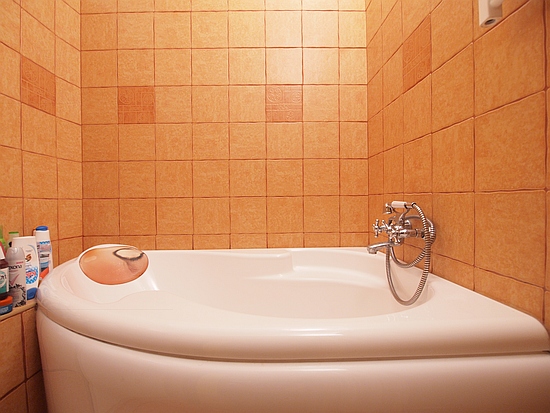 Field of view of the Olympus M.Zuiko Digital ED 9-18mm f/4-5.6 Micro Four Thirds lens
Field of view of the Olympus M.Zuiko Digital ED 9-18mm f/4-5.6 Micro Four Thirds lens
Defishing
We took the above photo captured with the Olympus 9mm Fisheye Body Cap lens and imported it into the open-source application Hugin for “defishing.” As you can see below, the resultant image is still wider than what you can capture with the 9-18mm zoom lens at the 9mm setting. Naturally, all this transformation comes at a price: the corners now have a lot less resolution than the centre.
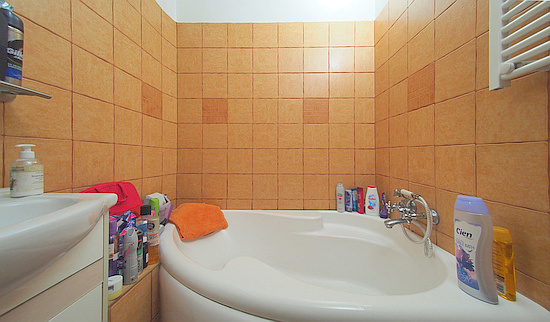 Fisheye shot “defished” with Hugin
Fisheye shot “defished” with Hugin
Focusing
As mentioned earlier, you can, for the most part, leave the focus lever set to the hyperfocal distance as the vast depth of field of the lens ensures that pretty much everything will be in focus. However, if you need to focus real close, you can do so by sliding the lever toward the 0.2m mark. Said lever is not in the most convenient location, and might be a little hard to find at first without looking, but otherwise does its job decently. The only other problem inherent in its design is that it's unfortunately possible to focus beyond infinity, which will result in out-of-focus images – so make sure not to bump it by accident.
Flare

A wide-angle lens will always be susceptible to flare, especially if no lens hood can be attached to it. For this reason, we were rather pleasantly surprised to see that the Olympus 9mm f8 Fisheye Body Cap Lens actually exhibits a fairly high degree of flare resistance, with only a minimal amount of veiling seen in the images, even with the sun in the frame.
Chromatic Aberrations
Chromatic aberrations, typically seen as purple or green fringes along contrasty edges, are a problem with this lens, although you may be able to reduce them in post-processing. A “proper” - and more expensive – fisheye lens, such as the Panasonic Lumix G Fisheye 8mm f/3.5, will perform considerably better here.
 |
 |
Light Fall-off
In real-world images, there's fairly little light fall-off in the corners. Some vignetting is seen but it's nothing to worry about really.

Macro
The Olympus 9mm f8 Fisheye Body Cap is not a macro lens. Even at its close-focus point of 0.2m, it captures a very wide area with a 0.05x maximum magnification. The photo below shows how “close” you can get to the subject – in this case, a weather-beaten CompactFlash memory card.
 Close-up performance
Close-up performance
Bokeh
Bokeh is a word used for the out-of-focus areas of a photograph, and is usually described in qualitative terms, such as smooth / creamy / harsh etc. With a 9mm fisheye lens, it's rather difficult to throw anything completely out of focus – you pretty much need to set the focusing lever to the 0.2m position and use a background that is really far away to achieve a bokeh effect. The crops below demonstrate what you should expect in this case.
 |
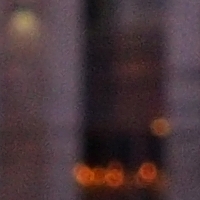 |
 |
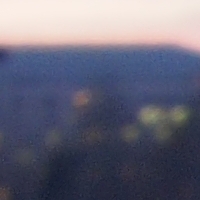 |
